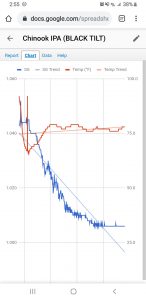Ok, we start with the yeast starter. I pulled up a UTube video to remind myself of the ratio. The guy said 1/2 cup DME to 2 cups water. For my 2L Erlenmeyer flask, it was 2 cups DME and 2 cups DME. That was the absolute maximum volume for the flask.
All went well until it was time to cool the wort. While I had successfully used a reverse flow chiller in the past, this time it simply would not prime properly. After several failed attempts, that method was abandoned. Plan B was simply to hose down the brew kettle. The recipe specified 100F before transfering the wort to the fermenter. It was only 2.5 gallons, requiring the addition of cool water to bring the volume up and cool the mixture further. I added perhaps a bit too much, perhaps resulting in about 6 gallons total. This reduced OG reading, only 1.038 while the target was 1.05.
So I boiled up some DME to compensate.
After “pitching” the DME, the OG climbed to 1.044. While still below the target 1.05 called out in the recipe, it was certainly an improvement.
I did some additional reading and plan to try the consensus method of adding dextrose next batch instead of DME.
Then, the wort was moved to a small room with a portable AC unit blasting to cool the wort. It was 66F in the morning, perfect for pitching the yeast. A good thing as 95+ was forecast.
I was heading out of town for the weekend, leaving the wort on the north side of my house with a ceiling fan running for cooling.
This was my first batch using the Tilt Bluetooth hydrometer/thermometer. With thos device, the fermentation process can be monitored remotely with time-tagged wort gravity and temperature recorded and viewable on-line at an interval of your choosing. I set it for 15 minute intervals.
While away for a few days, the gravity dropped all the way down to the final value of 1.006. It became obvious when the fermentation complete as the gravity flat-lined.

4-day Fermentation
Instead of waiting the usual 2-week period for fermentation to complete, I was able to move on after 4 day. The data shows it was actually done after 3 days.
I transfered the batch to a sanitized 6 gallon container, cleaned out the primary fermenter, and then transfered the product back to the primary fermenter. I find this double transfer cleans out most of the trub from the boil.
I let it rest for a week before adding hops for the dry-hop process. The recipe called out 1 ounce of additional Chinook hops, but after reading some home brew post I decided to double it up to 2 ounces to really pop out the bitter notes.
September 15 was bottle/kegging day. Six 22 ounce bottles were filled with the rest emptied into the keg. A sample was drawn (not carbonated or conditioned). Interesting carmel notes. This will be a pleasant drinkable batch.